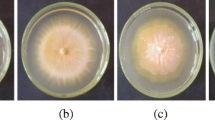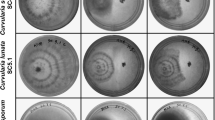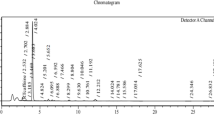Abstract
In this study, we have investigated the effects of three lipopeptides (fengycin, surfactin and mycosubtilin) produced by different strains of Bacillus subtilis against the phytopathogenic fungi Fusarium oxysporum f. sp. iridacearum, which affects the ornamental bulb plant populations of Iris sp. The antifungal effects were tested using minimum inhibitory concentration assay, determination of mycelium growth and spore germination inhibition rates. Also, in vivo tests on infected rhizomes and scanning electron microscopy were employed. Mycosubtilin alone and in combination with fengycin or/and surfactin showed potent inhibitory activity at concentrations as low as 5 μg ml−1 which is 100 times lower compared to Topsin M, a common chemical fungicide frequently used against fusariosis in ornamental plants. An enhancement of mycosubtilin antifungal activity was observed when it was used in combination with surfactin due to a synergistic effect. At a concentration of 20 μg ml−1, mycosubtilin inhibited the growth of the mycelium up to 49% and the spore germination ability up to 26% in comparison to control. In addition, significant changes on the macro- and micro-morphology have been observed. The antifungal activity is related to the inhibition of spore germination and the irreversible damage of the hyphae cell wall. To the best of our knowledge, this is the first attempt to propose the lipopeptides as biopesticides against the fusariosis of ornamental plants.





Similar content being viewed by others
References
Arens P, Bijman N, Tang N, Shahin A, van Tuyl JM (2012) Mapping of disease resistance in ornamentals: a long haul. In: Orlikowska T (ed) Proceedings of the 24th International Eucarpia Symposium Section Ornamentals “Ornamental Breeding Worldwide”. Warsaw, Vol. 953 pp 231-238
Baayen RP, O’Donnell K, Bonants PJJM, Cigelnik E, Kroon LPNM, Roebroeck EJA, Waalwijk C (2000) Gene genealogies and AFLP analyses in Fusarium oxysporum complex identify mononphyletic and nonmonophyletic formae speciales causing wilt and rot disease. Phytopathology 90:891–900. doi:10.1094/PHYTO.2000.90.8.891
Béchet M, Castéra-Guy J, Guez JS, Chihib NE, Coucheney F, Coutte F, Fickers P, Leclère V, Wathelet B, Jacques P (2013) Production of a novel mixture of mycosubtilins by mutants of Bacillus subtilis. Bioresour Technol 145:264–270. doi:10.1016/j.biortech.2013.03.123
Besson F, Peypoux F, Michel G, Delcambe L (1979) Antifungal activity upon Saccharomyces cerevisiae of iturin A, mycosubtilin, bacillomycin L and of their derivatives; inhibition of this antifungal activity by lipid antagonists. J Antibiot 32: 828-833. doi.org/10.7164/antibiotics.32.828
Chang T, Ko W (1992) Variation in growth rate and colony morphology of Phytophthora parasitica induced by metalaxyl. Ann Phytopathol Soc Japan 58:72–77. doi:10.3186/jjphytopath.58.72
Chung WH, Chung CW, Ting PF, Ru CC, Huang HC, Huang JW (2009) Nature of resistance to methyl benzimidazole carbamate fungicides in Fusarium oxysporum f. sp. lilii and F. oxysporum f. sp. gladioli in Taiwan. J Phytopathol 157:742–747. doi:10.1111/j.1439-0434.2009.01545
Coutte F, Leclère V, Béchet M, Guez JS, Lecouturier D, Chollet-Imbert M, Dhulster P, Jacques P (2010a) Effect of pps disruption and constitutive expression of srfA on surfactin productivity, spreading and antagonistic properties of Bacillus subtilis 168 derivatives. J Appl Microbiol 109: 480–491. doi:10.1111/j.1365-2672.2010.04683.x
Coutte F, Lecouturier D, Yahia SA, Leclère V, Béchet M, Jacques P, Dhulster P (2010b) Production of surfactin and fengycin by Bacillus subtilis in a bubbleless membrane bioreactor. Appl Microbiol Biotechnol 87:499–507. doi:10.1007/s00253-010-2504-8
Coutte F, Lecouturier D, Leclère V, Béchet M, Jacques P, Dhulster P (2013) New integrated bioprocess for the continuous production, extraction and purification of lipopeptides produced by Bacillus subtilis in membrane bioreactor. Process Biochem 48:25–32. doi:10.1016/j.procbio.2012.10.005
Deepak R, Jayapradha R (2015) Lipopeptide biosurfactant from Bacillus thuringiensis pak2310: a potential antagonist against Fusarium oxysporum. J Mycol Med 25:15-24. doi:org/10.1016/j.mycmed.2014.10.011
Deravel J, Lemière S, Coutte F, Krier F, Van Hese N, Bechet M, Sourdeau N, Hofte M, Lepretre A, Jacques P (2014) Mycosubtilin and surfactin are efficient, low ecotoxicity molecules for the biocontrol of lettuce downy mildew. Appl Microbiol Biotechnol 98:6255–6264. doi:10.1007/s00253-014-5663-1
Eurostat reports (2016) Agri-environmental indicator—consumption of pesticides, Pesticides sale (aei_fm_salpest), (aei_fm_salpest09)
Farace G, Fernandez O, Jacquens L, Coutte F, Krier F, Jacques P, Clément C, Ait Barka E, Jacquard C, Dorey S (2015) Cyclic lipopeptides from Bacillus subtilis activate distinct patterns of defence responses in grapevine. Mol Plant Pathol 16:177–187. doi:10.1111/mpp.12170
Fiedler Z, Sosnowska D (2014) Side effects of fungicides and insecticides on predatory mites, in laboratory conditions. J Plant Prot Res 54:349–353. doi:10.2478/jppr-2014-0052
Gond SK, Bergen MS, Torres MS, White JF (2015) Endophytic Bacillus spp. produce antifungal lipopeptides and induce host defence gene expression in maize. Microbiol Res 172:79–87. doi:10.1016/j.micres.2014.11.004
Gong AD, Li HP, Yuan QS, Song XS, Yao W, He WJ, Zhang JB, Liao YC (2015) Antagonistic mechanism of iturin A and plipastatin A from Bacillus amyloliquefaciens S76-3 from wheat spikes against Fusarium graminearum. PLoS One 10:e0116871. doi:10.1371/journal.pone.0116871
Gullino ML, Daughtrey ML, Garibaldi A, Elmer WH (2015) Fusarium wilts of ornamental crops and their management. Crop Prot 73:50–59. doi:10.1016/j.cropro.2015.01.003
Guo Q, Dong W, Li S, Lu X, Wang P, Zhang X, Wang Y, Ma P (2014) Fengycin produced by Bacillus subtilis NCD-2 plays a major role in biocontrol of cotton seedling damping-off disease. Microbiol Res 169:533–540. doi:10.1016/j.micres.2013.12.001
Hameed N, Jan S, Gul H, Wali S, Hamayun M, Ahmad I (2015) Topsin-M application affected nucleic acid, amino acid and phenol contents of Cicer arietinum L. Int J Biosci 6:140-146. doi:10.12692/ijb/6.2.140-146
Hamley IW, Dehsorkhi A, Jauregi P, Seitsonen J, Ruokolainen J, Coutte F, Chataigne G, Jacques P (2013) Self-assembly of three bacterially-derived bioactive lipopeptides. Soft Matter 9:9572–9578. doi:10.1039/C3SM51514A
Jacques P (2011) Surfactin and other lipopeptides from Bacillus spp. In: Soberon-Chavez G (ed) Biosurfactants microbiology monographs, vol 20. Springer-Verlag, Heidelberg, pp 57–91
Kargar MH, Imani A (2011) Effects of fungicides on pollen germination peach and nectarine in vitro. African J Plant Sci 5:643–647 ISSN 1996-0824
Leclère V, Bechet M, Adam A, Guez JS, Wathelet B, Ongena M, Thonart P, Gancel F, Chollet-Imbert M, Jacques P (2005) Mycosubtilin overproduction by Bacillus subtilis BBG100 enhances the organism’s antagonistic and biocontrol activities. Appl Environ Microbiol 71:4577–4584. doi:10.1128/AEM.71.8.4577-4584.2005
Lecomte C, Alabouvette C, Edel-Hermann V, Robert F, Steinberg C (2016) Biological control of ornamental plant diseases caused by Fusarium oxysporum: a review. Biol Control 101:17–30. doi:10.1016/j.biocontrol.2016.06.004
Li X, Zhang Y, Wei Z, Guan Z, Cai Y, Liao X (2016) Antifungal activity of isolated Bacillus amyloliquefaciens SYBC H47 for the biocontrol of peach gummosis. PLoS One 11:e0162125. doi:10.1371/journal.pone.0162125
Maget-Dana R, Peypoux F (1994) Iturins, a special class of poreforming lipopeptides: biological and physicochemical properties. Toxicology 87:151–174. doi:10.1016/0300-483X(94)90159-7
Maget-Dana R, Thimon L, Peypoux F, Ptak M (1992) Surfactin/iturin A interactions may explain the synergistic effect of surfactin on the biological properties of iturin A. Biochimie 74:1047–1051. doi.org/10.1016/0300-9084(92)90002-V
Martínez-Viveros O, Jorquera MA, Crowley DE, Gajardo G, Mora ML (2010) Mechanisms and practical considerations involved in plant growth promotion by rhizobacteria. J Soil Sci Plant Nutr. doi:10.4067/S0718-95162010000100006
Meena KR, Kanwar SS (2015) Lipopeptides as the antifungal and antibacterial agents: applications in food safety and therapeutics. Biomed Res Int vol. 2015, Article ID 473050, 9 pages. doi:10.1155/2015/473050
Mnif I, Hammami I, Triki MA, Azabou CM, Ellouze-Chaabouni S, Ghribi D (2015) Antifungal efficiency of a lipopeptide biosurfactant derived from Bacillus subtilis SPB1 versus the phytopathogenic fungus, Fusarium solani. Environ Sci Pollut Res 22:18137–18147. doi:10.1007/s11356-015-5005-6
Moyne AL, Shelby R, Cleveland TE, Tuzun S (2001) Bacillomycin D: an iturin with antifungal activity against Aspergillus flavus. J Appl Microbiol 90:622–629. doi:10.1046/j.1365-2672.2001.01290.x
Nosir W, McDonald J, Woodward S (2011) Impact of biological control agents on fusaric acid secreted from Fusarium oxysporum f. sp. gladioli (Massey) Snyder and Hansen in Gladiolus grandiflorus corms. J Ind Microbiol Biotechnol 38:21–27. doi:10.1007/s10295-010-0842-2
Ongena M, Jourdan E, Adam A, Paquot M, Brans A, Joris B, Arpigny JL, Thonart P (2007) Surfactin and fengycin lipopeptides of Bacillus subtilis as elicitors of induced systemic resistance in plants. Environ Microbiol 9:1084–1090. doi:10.1111/j.1462-2920.2006.01202.x
Ongena M, Jacques P (2008) Bacillus lipopeptides: versatile weapons for plant disease biocontrol. Trends Microbiol 16:115–125. doi:10.1016/j.tim.2007.12.009
Palmero D, Rubio-Moraga A, Galvez-Patón L, Noguresa J, Abato C, Gomez-Gomez L, Ahrazem O (2014) Pathogenicity and genetic diversity of Fusarium oxysporum isolates from corms of Crocus sativus. Ind Crop Prod 61:186–192. doi:10.1016/j.indcrop.2014.06.051
Paranjape K, Gowariker V, Krishnamurthy VN, Gowariker S (2014) The pesticide encyclopedia. CPI Group Ltd, Croydon, pp 479–480
Romero D, Vicente A, Rakotoaly R, Dufour S, Veening JW, Arrebola E, Cazorla F, Kuipers O, Paquot M, Pérez-García A (2007) The iturin and fengycin families of lipopeptides are key factors in antagonism of Bacillus subtilis toward Podosphaera fusca. Mol Plant Microbe 20:430–440. doi:10.1094/MPMI-20-4-0430
Siah A, Deweer C, Morand E, Reignault P, Halama P (2010) Azoxystrobin resistance of French Mycosphaerella graminicola strains assessed by four in vitro bioassays and by screening of G143A substitution. Crop Prot 29:737–743. doi:10.1016/j.cropro.2010.02.012
Tao Y, Bie X, Lv F, Zhao H, Lu Z (2011) Antifungal activity and mechanism of fengycin in the presence and absence of commercial surfactin against Rhizopus stolonifer. J Microbiol 49:146–150. doi:10.1007/s12275-011-0171-9
Tendulkar SR, Saikumari YK, Patel V, Raghotama S, Munshi TK, Balaram P, Chattoo BB (2007) Isolation, purification and characterization of an antifungal molecule produced by Bacillus licheniformis BC98, and its effect on phytopathogen Magnaporthe grisea. J Appl Microbiol 103:2331–2339. doi:10.1111/j.1365-2672.2007.03501.x
Torres MJ, Brandan CP, Petroselli G, Erra-Balsells R, Audisio MC (2016) Antagonistic effects of Bacillus subtilis subsp. subtilis and B. amyloliquefaciens against Macrophomina phaseolina: SEM study of fungal changes and UV-MALDI-TOF MS analysis of their bioactive compounds. Microbiol Res 182:31–39. doi:10.1016/j.micres.2015.09.005
Troisi M, Gullino ML, Garibaldi A (2010) Gerbera jamesonii, a new host of Fusarium oxysporum f.sp. tracheiphilum. J Phytopathol 158:8–14. doi:10.1111/j.1439-0434.2009.01551.x
Vitullo D, Di Pietro A, Romano A, Lanzotti V, Lima G (2012) Role of new bacterial surfactins in the antifungal interaction between Bacillus amyloliquefaciens and Fusarium oxysporum. Plant Pathol 61:689–699. doi:10.1111/j.1365-3059.2011.02561.x
Wang J, Liu J, Chen H, Yao J (2007) Characterization of Fusarium graminearum inhibitory lipopeptide from Bacillus subtilis IB. Appl Microbiol Biotechnol 76:889–894. doi:10.1007/s00253-007-1054-1
Wilson GWT, Williamson MM (2008) Topsin-M: the new benomyl for mycorrhizal-suppression experiments. Mycologia 100:548–554. doi:10.3852/08-024R
Yao S, Gao X, Fuchsbauer N, Hillen W, Vater J, Wang J (2003) Cloning, sequencing, and characterization of the genetic region relevant to biosynthesis of the lipopeptides iturin A and surfactin in Bacillus subtilis. Curr Microbiol 47:272–277. doi:10.1007/s00284-002-4008-y
Zhang SM, Wang YX, Meng LQ, Zhao XY, Cao X, Chen XL, Wang AX, Li JF (2012) Isolation and characterization of antifungal lipopeptides produced by endophytic Bacillus amyloliquefaciens TF28. Afr J Microbiol Res 6:1747–1755. doi:10.5897/AJMR11.1025
Zhao P, Quan C, Wang Y, Wang J, Fan S (2014) Bacillus amyloliquefaciens Q-426 as a potential biocontrol agent against Fusarium oxysporum f. sp. spinaciae. J Basic Microbiol 54:448–456. doi:10.1002/jobm.201200414
Zheng XB, Ko WH (1997) Continuing variation in colony morphology and fungicide sensitivity in Phytophthora cinnamomi following exposure to chloroneb. Bot Bull Acad Sin 38:177–182
Acknowledgements
The authors would like to thank Professor PhD Catalin Tanase, Director of Botanic Garden of Iasi, for her kind support and Corentin Duthoo for his participation in lipopeptide purification. Part of this work was supported by two PHCs—Brancusi partnership grants: project number 780/30.06.2014 and Romanian National Authority for Scientific Research and project number 32634WC (lipofleur)—Campus France. This work was also partially supported by the project NewBioPest funded by the Regional Council Nord Pas-de-Calais, by the Alibiotech project financed by European Union, French State and the French Region of Hauts-de-France and by the European Funds of INTERREG V FWVL Bioprod Project. We thank Dr. Debarun Dhali for the English proofreading.
Author information
Authors and Affiliations
Corresponding author
Ethics declarations
Conflict of interest
The authors declare that they have no competing interest.
Additional information
Responsible editor: Philippe Garrigues
Rights and permissions
About this article
Cite this article
Mihalache, G., Balaes, T., Gostin, I. et al. Lipopeptides produced by Bacillus subtilis as new biocontrol products against fusariosis in ornamental plants. Environ Sci Pollut Res 25, 29784–29793 (2018). https://doi.org/10.1007/s11356-017-9162-7
Received:
Accepted:
Published:
Issue Date:
DOI: https://doi.org/10.1007/s11356-017-9162-7




